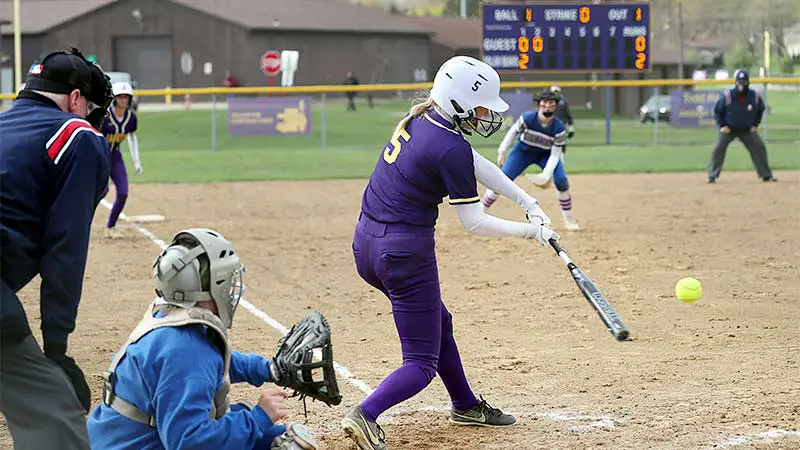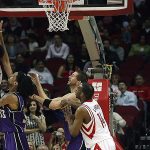If you’re making contact with the ball often and getting on base frequently but can’t remember the last time you hit a home run, then you’re likely a contact hitter.
Contact hitters excel at making consistent contact with the ball, focusing on singles and doubles rather than power hits. Your role in the lineup is crucial: getting on base and advancing runners, especially those on third.
As a contact hitter, your bat choice can make all the difference. Balanced bats, with their evenly distributed weight, offer higher swing speeds and greater control through the hitting zone.
This balance helps you maintain precision, making it easier to place the ball where the defense isn’t. Understanding your strengths and choosing the right equipment can significantly enhance your performance on the field.
Defining the Contact Hitter
In the intricate realm of baseball strategy and player specialization, contact hitters are essential.
They prioritize accurate and consistent contact with the ball over sheer power, showcasing a blend of skill, finesse, and strategic intelligence that can significantly influence a game’s outcome.
Key Characteristics
Contact hitters focus on making consistent contact with the ball to get on base with singles and doubles. Unlike power hitters, they prioritize accuracy over strength. A lower strikeout rate is a defining trait; players like Josh Bell exhibit this with an 18.8% career strikeout rate.
Additionally, they usually maintain a high batting average; for instance, Justin Turner boasts a .290 career average.
Role in a Baseball Team
Contact hitters play a crucial role in setting the table for power hitters. By getting on base frequently, they create scoring opportunities. Players like Jean Segura, with a career strikeout rate under 16%, excel in this role because they put the ball in play consistently.
Their ability to produce hits and move runners underscores their value in the lineup.
Evolution of Contact Hitting
Contact hitting, the skill of making precise and consistent contact with the baseball, has evolved significantly throughout baseball history.
From the sport’s early days to the current era of advanced analytics and specialized training, contact hitters have continually adapted their techniques and approaches to meet the game’s changing demands.
Historical Overview
Contact hitting has always been a crucial part of baseball. In the early 20th century, hitters like Ty Cobb and Honus Wagner exemplified this approach. Players focused on making contact and getting on base, which was vital in an era where power hitting was less prevalent.
Cobb, for instance, had a career batting average of .366, the highest in MLB history. This style of play continued through the early and mid-20th century, with players like Tony Gwynn and Rod Carew maintaining high batting averages by prioritizing consistent contact.
Changes in Techniques Over the Years
Modern contact hitting techniques have evolved significantly, with players now focusing heavily on advanced metrics like Hit Swing, Contact Rate, and Strikeout Rate to refine their performance.
Emphasizing swing mechanics and plate discipline, players such as Justin Turner and José Altuve use data-driven insights to enhance their in-play success.
Adjustments like modifying launch angles, integrating video analysis into training, and tailored workout regimens have enabled contemporary contact hitters to maintain high averages and reduce strikeouts.
Analyzing Top Contact Hitters in MLB
Analyzing contact hitters in MLB reveals their significant influence on the game, extending beyond mere statistics. These players, recognized for consistently making solid contact with the ball, play a crucial role in the sport’s dynamics.
Evaluating these elite performers involves specific criteria that underscore their profound impact on the field.
Criteria for Ranking
When analyzing top contact hitters in MLB, several key metrics are considered important. The primary criteria include:
- Strikeout Rate (K%): This represents the percentage of a player’s plate appearances ending in a strikeout. High contact hitters typically have low strikeout rates.
- Contact Rate (Contact%): This metric measures how often a player’s swings result in contacting the ball. It’s a critical stat as it directly highlights the player’s ability to hit the ball.
- Hard-Hit Rate (HardHit%): This indicates the frequency of batted balls that have an exit velocity of 90 mph or more. Good contact hitters often produce solid contact, sending balls into play efficiently.
- Hit/Swing Percentage (Hit/Swing%): This unique statistic tracks the percentage of swings resulting in hits. It helps to distinguish efficient hitters from those who make weaker contacts.
For example, Nick Madrigal and Trea Turner showcase these attributes effectively. Madrigal boasts one of the lowest strikeout rates, while Turner’s consistent contact rate led him to 195 hits in the 2021 season.
Impact on Game Outcomes
Contact hitters play a pivotal role in influencing game outcomes. By consistently putting balls in play, they pressure the defense, create scoring opportunities, and sustain rallies.
Here are a few ways contact hitters impact games:
Run Generation
Contact hitters like José Altuve and David Fletcher maintain high on-base percentages, leading to more scoring chances for power hitters. Altuve’s ability to get on base provides ample RBI opportunities for teammates.
Reducing Strikeouts
With their low strikeout rates, contact hitters help keep innings alive. Players like Kevin Newman, who ranked among the top contact hitters without requiring many plate appearances, ensure fewer wasted outs.
Defensive Pressure
By frequently putting balls in play, contact hitters force defenses to make plays, increasing the likelihood of errors. Trea Turner, with his top-of-the-scale speed and contact efficiency, exemplifies this, creating additional baserunning pressure.
Lineup Balance
Contact hitters balance lineups by providing a mix of power and precision. Teams featuring balanced hitters, such as those with Mookie Betts or Tony Gwynn, tend to have more consistent offensive performances.
Techniques and Training for Contact Hitters
Mastering contact hitting involves refined technique, disciplined approach, and diligent training. Seasoned professionals and aspiring players alike can enhance their performance and contribute to their team’s success by honing these skills.
Essential techniques and training methods tailored for contact hitters will be explored.
Batting Techniques
Refining batting techniques is crucial for excelling as a contact hitter. Focus on developing a compact, quick swing that maximizes bat control. Keep your hands inside the baseball to ensure better coverage of the strike zone.
Practice staying balanced with a consistent stance to enhance your timing and improve pitch recognition. Emulate players like José Altuve, who maintain a controlled, short swing to make consistent contact.
Work on identifying various pitch types during live batting practice sessions to improve your adaptability mid-game.
Strength and Conditioning
Strength and conditioning are crucial for peak performance throughout the season. Incorporate core stability and rotational power exercises to enhance swing mechanics, and build lower body strength with squats and lunges for better stability and power transfer.
Include flexibility and mobility drills to ensure a full range of motion and reduce injury risks. Use resistance training to develop muscle endurance for consistent performance over multiple plate appearances.
A well-rounded conditioning program can help emulate the durability and resilience of top contact hitters like Tommy Edman.
Frequently Asked Questions
What is contact hitting in baseball?
Contact hitting in baseball refers to the focus on making precise and consistent contact with the ball rather than hitting it for power. Contact hitters often have a high batting average and strike out less frequently.
Who are some notable contact hitters in baseball history?
Historical contact hitters include legends like Ty Cobb and Honus Wagner. In modern baseball, players like Josh Bell, Justin Turner, and José Altuve are recognized for their contact hitting skills.
What techniques are used by contact hitters?
Contact hitters use techniques such as maintaining a compact swing, enhancing bat control, and focusing on balance. They often use balanced bats to improve their hitting accuracy.
How important is strength and conditioning for contact hitters?
Strength and conditioning are crucial for contact hitters. Exercises that improve swing mechanics and overall performance, as exemplified by players like Tommy Edman, are vital for success.
What role do contact hitters play in baseball games?
Contact hitters influence game outcomes by getting on base consistently and providing a strategic advantage for their teams. Their ability to make contact with the ball can create scoring opportunities and pressure opposing defenses.
Conclusion
Contact hitters play a crucial role in shaping the dynamics of baseball. By focusing on precision and technique, these players can consistently get on base and set the stage for their power-hitting teammates.
Whether you’re a coach, player, or fan, understanding the nuances of contact hitting can enhance your appreciation of the game. Refine your skills, stay disciplined in your training, and you’ll see the impactful difference a proficient contact hitter can make.
Analyzing stats like batting average and on-base percentage can offer insights into a contact hitter’s effectiveness.
Additionally, adopting strategies such as situational hitting and bunting can maximize opportunities, making them indispensable assets to any lineup.
Being mindful of pitch selection and timing further enhances a contact hitter’s success. Leveraging these aspects not only elevates individual performance but also contributes to a well-rounded, powerful team strategy.








Pat Bloom